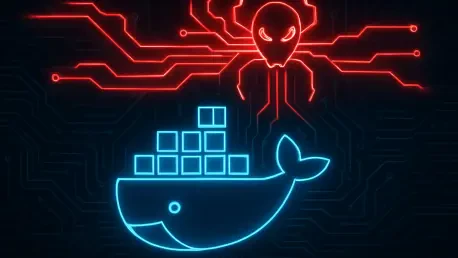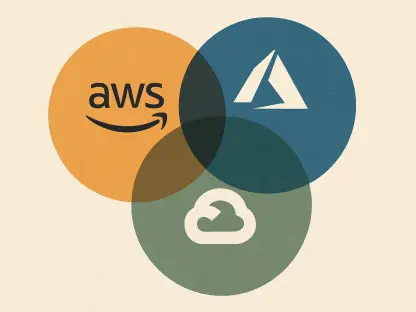In an era where containerized environments are pivotal to modern IT infrastructure, a chilling new threat has emerged that targets Docker APIs with unprecedented sophistication, posing a severe risk to system security. Recently identified through advanced honeypot systems, this malware variant represents a significant leap in cyberattack strategies, exploiting misconfigured APIs to gain full root access on compromised hosts. Unlike earlier threats, this strain not only establishes persistent control but also actively blocks other attackers from exploiting the same vulnerabilities. First detected in recent months, it builds on tactics observed earlier this year, showcasing a disturbing evolution with multiple infection tools and the potential to form a distributed botnet. This development raises critical questions about the security of container technologies, which are widely adopted for their scalability and efficiency. As cybercriminals refine their methods, understanding the intricacies of this attack becomes essential for safeguarding digital assets against such invasive threats.
Unveiling the Attack Mechanism
The sophistication of this malware lies in its calculated approach to infiltrating Docker environments through exposed APIs. It initiates its assault with an HTTP POST request aimed at the Docker daemon’s remote API, typically accessible on port 2375, a common oversight in misconfigured setups. Once inside, the malware deploys an Alpine Linux container, granting it access to the host’s filesystem—a critical breach of security boundaries. From there, it executes a Base64-encoded command to install utilities like curl and Tor, pulling a secondary script from a hidden service on the Tor network. This script alters the host’s SSH configuration, enabling root login and embedding a malicious public key for sustained backdoor access. Such a multi-stage infection process highlights the malware’s ability to not only penetrate but also entrench itself within the system, making removal a daunting task for even seasoned IT professionals tasked with defending against these stealthy incursions.
Beyond initial access, the malware takes deliberate steps to secure its foothold and expand its reach. A notable tactic is modifying the host’s crontab to establish a cron job that uses firewall tools to block port 2375, effectively locking out other potential attackers seeking to exploit the same entry point. Communication with a command-and-control (C2) server occurs via Tor, ensuring anonymity while it deploys a Go-based dropper packed with additional tools. The malware then employs Masscan to scout for other vulnerable Docker APIs across the internet, perpetuating its spread. Intriguingly, dormant code within its structure suggests future plans to target Telnet on port 23 and Chromium remote debugging on port 9222, indicating an intent to broaden its attack surface. This combination of persistence, lateral movement, and preemptive defense mechanisms underscores a new breed of territorial cyber threats that challenge conventional security paradigms.
Identifying the Threat Indicators
Detecting this malware requires vigilance for specific behavioral patterns that deviate from normal Docker operations. Key indicators include the creation of containers that install package managers or use tools like curl and wget for unauthorized downloads, often accompanied by unusual Base64 command executions. Connections to Tor .onion domains serve as a red flag, pointing to hidden communications with malicious servers. Additionally, the sudden closure of critical ports such as 2375, often through altered firewall rules via cron entries, suggests an attempt to monopolize the compromised system. Containers accessing sensitive host directories like /etc or /var/run/docker.sock further signal unauthorized activity that could compromise the entire environment. Recognizing these signs early is crucial for security teams aiming to intercept the threat before it escalates into a broader breach, necessitating robust monitoring systems capable of flagging such anomalies in real time.
Equally important is understanding the broader implications of these detection markers within containerized ecosystems. Unauthorized changes to SSH keys or crontab files often indicate persistent access mechanisms designed to survive reboots and routine maintenance. Such modifications, coupled with unexpected network traffic to obscure domains, paint a picture of a deeply embedded threat that could facilitate data theft or further exploitation. Security professionals must prioritize continuous auditing of container activities, ensuring that any deviation from baseline operations triggers immediate investigation. The presence of dormant exploit code for other services also hints at the malware’s potential evolution, urging a proactive stance in threat hunting. By correlating these indicators with network logs and system changes, organizations can build a comprehensive defense strategy to mitigate risks posed by this advanced malware, safeguarding critical infrastructure from cascading failures.
Strategies for Mitigation and Defense
To combat this evolving threat, organizations must adopt stringent measures to minimize Docker API exposure and fortify their defenses. Isolating Docker hosts behind internal firewalls is a fundamental step, ensuring that remote APIs are not accessible to the public internet. Restricting API access to trusted networks, coupled with enforcing robust credential policies, significantly reduces the attack surface. Regular monitoring for unauthorized changes to SSH configurations or crontab files is essential to detect persistence mechanisms early. Moreover, implementing network segmentation prevents lateral movement, confining potential breaches to isolated segments rather than allowing them to spread across the infrastructure. These proactive steps form a critical barrier against the malware’s ability to exploit misconfigurations, emphasizing the importance of layered security in containerized environments facing increasingly sophisticated threats.
Beyond immediate safeguards, a long-term commitment to security hygiene and threat intelligence is vital for staying ahead of such attacks. Continuous monitoring of Docker environments for suspicious container behavior, such as unexpected tool installations or connections to hidden services, enables rapid response to emerging threats. Leveraging advanced threat hunting techniques helps identify subtle indicators of compromise before they escalate into full-blown incidents. Organizations should also prioritize updating and patching Docker installations to close known vulnerabilities that malware might exploit. By fostering a culture of vigilance and integrating real-time alerts into security operations, businesses can disrupt the attack chain at its earliest stages. Reflecting on past encounters with this malware, it became evident that only through such comprehensive strategies could systems be shielded from the relentless ingenuity of cyber adversaries aiming to exploit container technologies.
Reflecting on Evolving Cyber Threats
Looking back, the emergence of this malware marked a pivotal moment in understanding the vulnerabilities inherent in Docker APIs, revealing how far cybercriminals had advanced in their tactics. Its multi-stage infection process, reliance on Tor for anonymity, and territorial behavior of blocking rival attackers underscored a shift toward more persistent and strategic threats. The lessons learned from dissecting its mechanisms emphasized the urgency of robust access controls and relentless monitoring to counter such sophisticated intrusions. Moving forward, organizations were encouraged to invest in network isolation and proactive threat hunting as essential defenses. By anticipating the activation of dormant exploit code targeting additional services, security teams could prepare for future iterations of this threat. Ultimately, the battle against this malware reinforced the need for a dynamic, adaptive approach to cybersecurity, ensuring that containerized environments remained resilient against the ever-evolving landscape of digital dangers.









